
|
|
||||||||
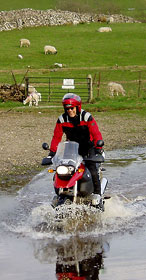 |
| Ah,
Yorkshire – Big puddles and willing sheep ... well, sheep.
Photo: Sarah Johnston |
Of all the companies out there, trust the Germans to be the most logical when it comes to updates of their models. Almost like clockwork, once every five or so years, the Bavarian company launch a new version of their famous Boxer twin motor and then spend the next five years updating each R model in the line-up with said new motor. It’s logical, simple and very BMW.
So it comes as no surprise that the first bike to get the new twin is their best global seller (and arguably in a niche they still rule), the dual-sport GS machine. But updating the best seller also opens up the possibility of making the biggest mess-up, so BMW is eager to prove their latest incarnation as a step in the right direction. And what better way to do that than to give one to CMG for a whole summer of abuse?
Although getting a long-termer model meant we were also passed over for the model’s international launch in South Africa (although in hindsight it would seem like a favourable compromise), it also meant that in order to get the primary test ride done, we’d either have to be creative, late or both.
The opportunity presented itself in the form of my annual trip to England, allowing me to grab a 1200GS from BMW’s southern outlet, tour my beloved homeland of North Yorkshire, and write-up what I thought about it soon afterwards – which, of course, you're reading now.
It also allowed me to fulfil one of my earliest motorcycle dreams – ride the area’s green lanes on a suitable dual-sport bike. And the timing couldn’t have been better – with England on the crest of a wave to drive off the scummy engine-powered vehicle from these historical untamed highways of green Britain, and leave them firmly in the domain of the hikers – this could be my last chance!
THE ‘ALI’ OF BOXER MOTORS
 |
| New
1200 motor has less weight and more power. Hmhh, I should do that.
Photo: Richard Seck |
I don’t want to repeat all of what was done to make the new 1200 motor as we’ve already covered all that in the 2004 New Model Buyers’ Guide – okay I do, but I won’t. Suffice to say that a 40cc increase due to a longer stroke (along with a host of other changes) means that power and torque are up a claimed 15%.
This boost is noticeable from the very start. A good handful of throttle will loft the front under power alone, and the revs rise much more eagerly than any Boxer before it. I think there’s even a bit of a power surge around 5,500rpm, with usable power being generated just above 3,000rpm and pulling strong till the 8,000rpm cut-off. It also likes to plod, enabling you to take it all gentle like, with enough power to pull from a tad under 2,000rpm in top.
What you’re left with is a motor that can be revved up for a good session of twisty road carving, or slapped into top and plodded along while you admire the unfolding countryside, smoking on a pipe.
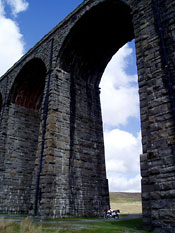 |
The first gear wasn't the only tall thing. The Ribblehead viaduct makes the GS feel small. Photo: Rob Harris |
It’s also the first Boxer to come with a balance shaft. Although a horizontal opposed twin should be inherently vibe-free, a slight cylinder off-set and the realities of life have meant that previous generations have had to rely on a tall overdrive top gear to keep it all respectable at speed. Although vibes are reduced, they’re still there, but in an “I can feel what the motor’s doing” way rather than an “I can’t feel my hands anymore” kind of way.
In the gearbox department, BMW have finally got a unit fit for the 21st Century. Although the 1150 was an improvement over the 1100 before it, it was still liable to hit a false neutral and was about as smooth as an Iraqi occupation plan (okay, maybe a bit smoother than that). You know a box is good when you don’t have any notes about it after a very intensive week of riding. Well, I do.
The only complaint I do have is that first gear seems a bit tall. Not too noticeable in everyday road usage, but if you take the GS up a rocky trail; you need to slip the clutch an awful lot to get it rolling after each stop. It’ll be interesting to see how the clutch copes over the long term – we’ll be sure to keep an eye on that as we are planning to put the long-term GS through its dirt paces.
Talking of the clutch, it’s hydraulically operated and proved to be relatively light with a good action … but being a dry format it does tend to smell somewhat up those rocky trails. Hopefully the (yet to be released) more dirt-aggressive 1200GS Adventure version will come with a lower first gear.
FLY WEIGHT?
 |
| Once
the rear tire finally bit, the rest of the hill was done at unfeasibly
high speed.
Photo: Sarah Johnston |
With a weight loss that would have any Weight-watchers fanatic reaching for a celebratory petroleum by-product goo pudding, the new GS finally reverses a weight-gaining trend with some interesting results. Although in the dirt it still feels unfeasibly lardy (because it is), like the generations before it, the big BMW requires that you trust it impeccably and anyone that does is rewarded with the impression of god-like skills.
Going back to that clutch-burning rocky hill-climb, when approached with caution, the GS feels heavy, unpredictable and liable to cause great pain at the first error. However, burn a bit of clutch and launch it at the upcoming obstacles and it suddenly becomes quite nimble, cooperative and able to charge through the most daunting of rock fields. I don’t know why this is, but it’s a f*%king rush when you take that leap of faith.
But the old 1150 would do this too (albeit with a greater threat of pain at the first error). Where the nimbler 1200 excels over the 1150 is on the twisty side-road.
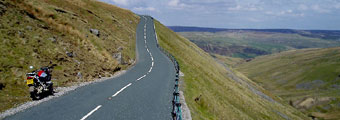 |
| Roads
like this are firmly within the R1200's grasp - and are loadsa fun
too!
Photo: Rob Harris |
Happily plodding along, puffing on some of Virginia’s finest in my pipe, swaying from curve to curve over the moors of the Yorkshire Dales, my peace was interrupted by some young ruffians on modern performance orientated machines.
With two passed and two to go, I decided to ditch the pipe, flat cap and plus fours and show these ruffians what riding was all about. Two gears down, revs up above 5 and 1/2, and I was on the leader’s arse like, err, umh … a pair of underpants (note to self – work on the analogies). Knee out and apex cutting corners was no problem, and I found myself braking more to avoid rear-ending the sporty oiks ahead, than to scrub off speed.
Overall speeds were on the high side, and grabbing air off some high-speed bumps was entertaining and a lot more comfortable returning to earth than my sporty prey, judging by my leader’s wobble and resulting odour. No two ways about it, the 1200’s weight loss (and power increase) has added unexpected, and welcomed, dimensions to its overall usage.
FLOAT LIKE A BUTTERFLY …
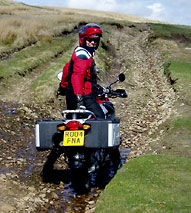 |
| No,
it's not a Montreal main road, but is a similar test for the GS's
suspension.
Photo: Jonathon Lewis |
Suspension is provided by the typical BMW set-up of the Telelever front and Paralever rear combo. The Telelever has the benefit of giving a goodly amount of travel without incurring a dive penalty during heavy braking. Although sometimes criticized for lack of feedback I think it’s the perfect set-up for this bike – giving enough shock absorption in the rocks and a stiff enough ride in the high-speed corners. The front is adjustable for preload, as is the rear, with the usual pre-load knob as well as some damping adjustment – although I just fiddled with the knob ...
The model I had came with the ABS option, which works as well as always and comes with a turn-off button on the bars. I remember this being a bit of a tricky to use option on the old 1150, but since I’m not a dirt purist – and actually quite like ABS in the lose stuff – I never tried to disengage it. Sorry about that. I promise to give it a go with the long-termer and report back my conclusions. Honest Guv’.
 |
| Servo-assist
ABS brakes work well – even in the wet.
Photo: Richard Seck |
Brakes are semi-integral (front operates both, but back is back alone) and with servo-assist. I know that the servo-assist has had a mixed reception, but with each generation it seems to get more refined. At this point the grabbiness seems to be gone and they just feel like really good brakes … although that high pitched servo-whine while waiting at the lights and looking cool for the passing ladies was cramping my style man. Or could that be the pipe, flat-cap and plus-fours? Nah.
The tires that came on my UK loaner were Bridgestone Trailwing 152s. Although obviously a heavy road-bias, they coped okay in the dirt. Well, rocky trails, as when any mud or slippery grass was encountered, the rear wheel would spin like a drunk two year old. It certainly made river crossings quite entertaining, but the only injury I sustained as a result was a couple of hearty bruises on my right shin, inflicted when the back-end slid around and smacked the cylinder against my supportive leg. Owwwwww! On the road however, they never let loose.
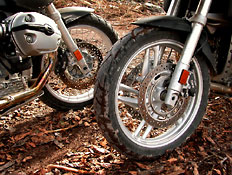 |
| Spokes
meet cast. Cast meet spokes.
Photo: Richard Seck |
Ground clearance/protection is provided by a large bash plate, which makes impressive banging noises every time you plonk it onto a big boulder. A quick inspection afterwards showed no sign of the abuse, although the centre-stand had a few long and deep scratches that weren’t there the day before.
Our long-termer back in Canada comes with spoke wheels, as we thought that prudent considering that we intend to do a lot of dirt riding over the summer. The UK bike came with cast wheels, which, to be honest, I half expected to have a couple of nice flats in the rim after some particularly spirited riding over large rocks. They didn’t, although a reasonably large 19” front wheel managed to ride over most obstacles, rather than into them.
THE TROUBLE WITH BAGS
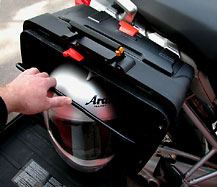 |
| Pulling
the lever down makes the bag bigger!
Photo: Richard Seck |
With the new GS come new bags. They’re a heavy-duty plastic skinned with aluminium, and are expandable by about 4 inches via a bar inside that you pull down 180 degrees to expand, or up to collapse. They also seem to be a lot sturdier than the similarly styled 650GS units (although Mr. Seck, who is currently riding the long-termer in Toronto, is reserving judgment) and the expanding system is soooo much easier.
Generally I found the mounting system to be relatively straightforward, although Mr. Seck again found it unnecessarily fiddley and difficult to mount and remove. One thing that we do both currently agree on is that closing the bags can be painful, as the door doesn’t always seem to line-up exactly with the case. I found a big wallop with a fist helps, but Mr. Seck takes a gentler approach to things and is still probably still trying to talk it closed as I write.
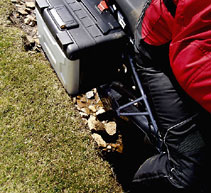 |
Uh oh. Wide bag kisses tall bank horror. Photo: Jonathon Lewis |
Fully expanded they’re wider than anything else on the bike, so traffic filtering (I’m in England remember) had to be done cautiously. I also once got into a bit of trouble traversing a particularly deep rut when the side-bag became lower than the rut and effectively pushed me into the middle of the track (which was muddy and not where I wanted to be at all).
But all was not happy in the world of bags. A solo last jaunt into the Dales saw me starting out with one bag and returning with none – leaving me with one short of a pair. And to be honest, I’m not really sure what happened. Okay, it did prove a bit tricky to mount in the morning (ooh err), but once on I gave it a firm wrenching to make sure it was secure. When I finally noticed its absence, the only clue was a lose knob bit where the bag locks around. I’m guessing that as this knob loosened off, the bag came up with it until it became free of the securing hooks, and then just let go.
 |
That metal knob is the bit that came loose. Little bastard. Photo: Richard Seck |
Since I suspect it may have come off on one the aforementioned rutty green lanes, there’s probably a group of hikers somewhere ceremoniously smashing and burning the remains (they don’t like vehicles on their lanes). Hopefully they’ll at least use the waterproofs and my UK atlas (with all the best roads marked in highlighter) contained within, for they are innocents in this sad and savage affair.
Sigh.
Although I have still not heard from the Ingleton/Settle/Harrogate police (useless sods), we shall be keeping an eye on this matter and the bags on our long-termer, to see whether this is a one-off or a potential problem of the mounting system. For sure, losing a bag and its contents could prove to be more than just an annoyance.
 |
Removing the rear seat gives a huge flat surface. Photo: Richard Seck |
Oh, before I forget, the rack on the back (plastic, painted silver) works well as a passenger grab bar, additional luggage area and can be used to mount a top box. However, it does scratch quite easily when using bungees. Talking of extra luggage space, the rear seat can be removed to reveal a large area for even more crap for the solo world traveler.
What the hell, while we’re on the subject, the front seat has a bar underneath at the front and one at the rear, Both can be moved up and down a slot to alter not only seat height, but also the fore and aft lean angle. Like all BMW adjustable seats, there’s a bit of a fiddle involved getting it back on, but it’s a lot easier with the rear part removed.
THE BEAUTY FACTOR
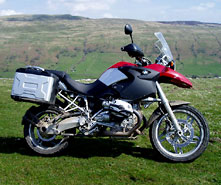 |
| Ugly?
Does it really matter if she's a good ride?
Photo: Rob Harris |
There’s an old joke I was reminded of during my visit to England; “Scooters are a bit like fat women – they’re fun to ride, but you wouldn’t want to be seen with one of them in front of your mates”. As sexist, yet wickedly amusing, as this is (c’mon, don’t get all PC on me now), I was a bit taken aback when a few of my mates pointed at the 1200GS and commented how ugly it was. One of them even compared it to the “good looking” 1150.
Okay, maybe I’m actually a ‘00s kinda guy after all, and don’t mind been seen with a skinny-challenged girl. Or maybe it’s just that the ride is so good that I can’t see the ugly façade, but I did find that a bit harsh. Granted, the bulbous black bits up front leave a little to be desired, but I like the minimalist exposed rear, the googly eyed face and the stubby red nose hanging out front.
I also think the bike doesn’t look that bad either.
Baboom, tisch!
Sorry, I couldn’t resist that one.
T’OTHER BITS
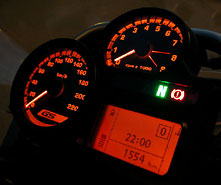 |
Smart clocks! Photo: Richard Seck |
Uh oh, the word count’s getting a bit high, so let me finish with a quick rundown of all the bits that I failed to neatly integrate into the article so far:
The clocks at the front are well laid out and (gasp) almost modern looking (this is an unusual thing for BMWs). Oddly the tripmeter reset button is actually on the left hand handlebar controls, which works fine, when you’ve found it. Unfortunately I kept resetting the clock for the first few gas fill-ups, until my passenger pointed at the handlebar button with “TRIP” on it.
The adjustable screen is actually only adjustable by angle and not height, but it does a remarkably good job at keeping the rider out of the main blast. So much so that after a day of jumping stones and carving up the back roads I hit the A1 highway and cruised at a steady 100mph (at a leisurely 6000rpm in top) for the next half hour. Besides being an experiment to see if English speed camera tickets can actually find their way to Canada, it confirms the GSs uncanny ability to do it all, and pretty damn well too!
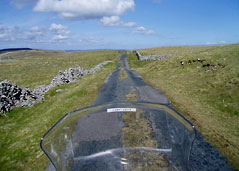 |
| "Keep
left". BMW UK were kind enough to make me a reminder.
Photo: Rob Harris |
The UK bike came with the optional GPS unit. Although we’re still negotiating to get one for the Canadian long-termer, initial impressions are very good. However, I suspect that an in-depth analysis would be an article unto itself, so let’s see if by avoiding talk of it now will force BMW’s hand in Canada into handing one over. C’mon Norm, you know you want to.
I took a passenger on the back a couple of times, and both of them seemed to be mighty impressed by the comfort, spaciousness, lack of vibration and my amazing riding. Okay, maybe I added one of those points.
Finally, Mr. Seck has issue with some of the ergonomics of the bike. So far I haven’t noticed anything other than good stuff, but he takes issue with the wide seat and tank, that doesn't allow his full foot to be placed on the pegs when you stand up in the dirt sections. Although, to quote Mr. Seck, “this wouldn't be a problem if you are bowlegged”. There are also the rear peg brackets that get in the way of his racing toes-on-the-pegs position. I haven’t noticed that yet, but he did prove me wrong with a similar complaint last year on the K1200GT. Yes, it’s true.
THE BRIGHT FUTURE?
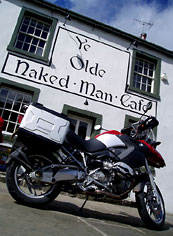 |
| Fat
bird, meet olde naked man.
Photo: Rob Harris |
After such an impressive first ride I think this summer is going to prove to be an interesting one with the GS. Apart from the usual touring duties, we’re going to subject it to some pretty rough trail riding (with some more suitable tires of course), just to see what she can do. This year’s planned CMG tour (if it comes off) should see it going about as far from civilization as possible*, and we’re even planning on taking it to the track (again, with suitable tires) to test that end of the spectrum.
The odd thing is, I don’t really have any reservations that it won’t be able to cope with such an array of duties.
I’m aware that this initial report is quite glowing, and I reserve the right to find faults and change my mind if required over the summer, but the 1200GS is so far proving to be a significant improvement on the 1150 – and that used to be my favourite machine. Hey, of the three journalists that I’ve talked to who attended the South African launch, two have said that they’re seriously considering buying a GS as their next bike. Journalists are cheap – so that’s impressive.
* Not including Mississauga
|
![]()
